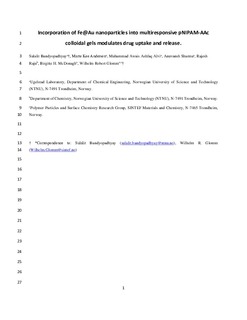Incorporation of Fe@Au nanoparticles into multiresponsive pNIPAM-AAc colloidal gels modulates drug uptake and release
Bandyopadhyay, Sulalit; Andersen, Marte Kee; Awais, Muhammad; Sharma, Anuvansh; Raju, Rajesh; McDonagh, Birgitte Hjelmeland; Glomm, Wilhelm
Journal article, Peer reviewed
Accepted version
Permanent lenke
http://hdl.handle.net/11250/2505212Utgivelsesdato
2016Metadata
Vis full innførselSamlinger
- Institutt for kjemi [1394]
- Institutt for kjemisk prosessteknologi [1777]
- Publikasjoner fra CRIStin - NTNU [38127]
Sammendrag
Here, a synthetic method has been optimized for the synthesis of thermoresponsive and pH-responsive poly(N-isopropylacrylamide-co-acrylic acid) nanogels which are subsequently loaded with cytochrome C by using a modified breathing-in mechanism. Physico-chemical properties mapped by using dynamic light scattering (DLS) and differential scanning calorimetry (DSC) confirm the swelling/deswelling kinetics as reversible with a volume phase transition temperature (VPTT) of ~39 °C. Fe@Au nanoparticles were incorporated inside the nanogel networks by using two different methods: coating and in situ growth. The latter bears closer resemblance to the nanogels only, while the former follows the trend of bare Fe@Au nanoparticles. High loading (~96 %) and encapsulation (500 μg/mg of nanogels) of cytochrome C were obtained. Release experiments performed by using a dialysis set-up and monitored by using UV-vis spectroscopy show the highest release at 40 °C and pH 3.2 (high temperature, low pH), with maximum release from the Fe@Au-coated nanogels that also show a reverse swelling-collapse trend. The location of the drug, the incorporation and presence of Fe@Au nanoparticles and the drug incorporation method are found to control both the drug release mechanism and kinetics.
